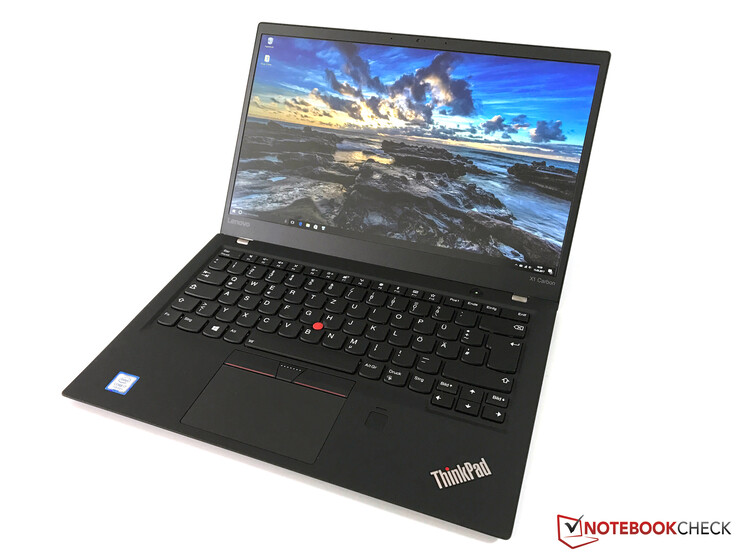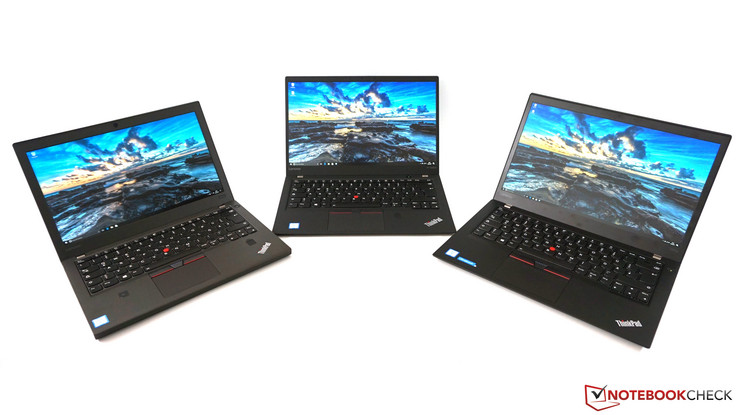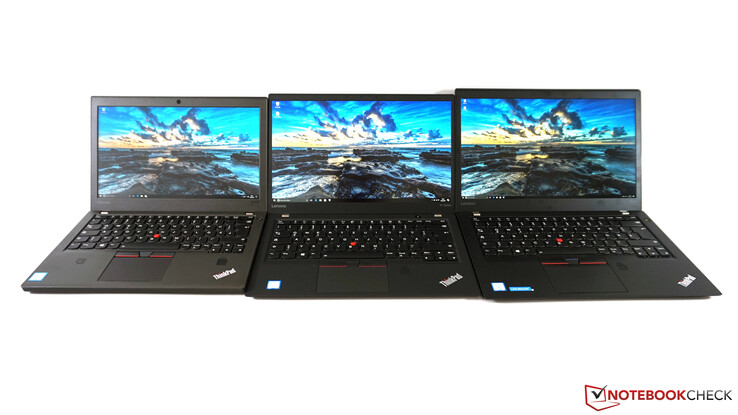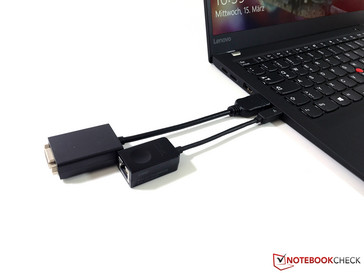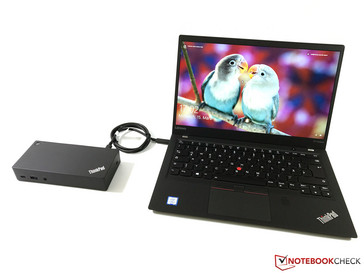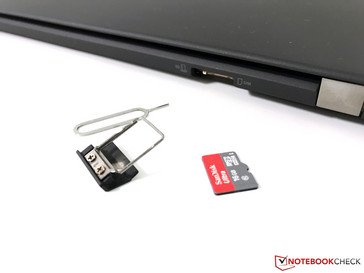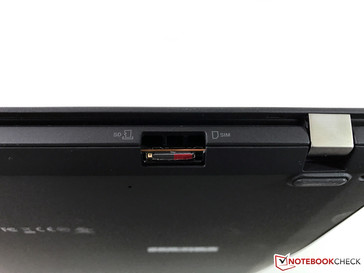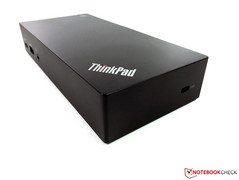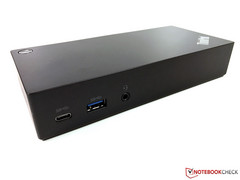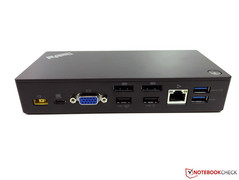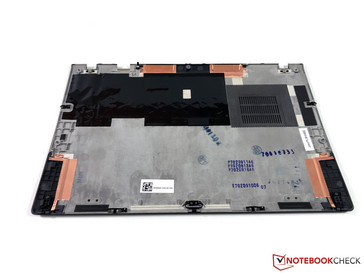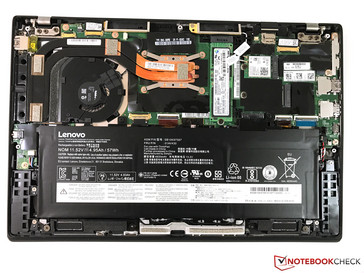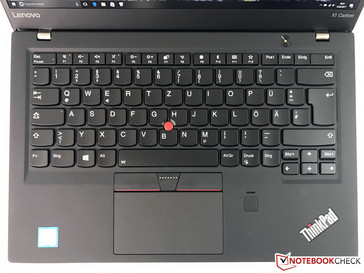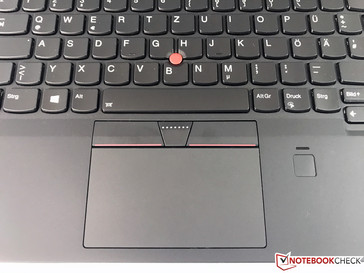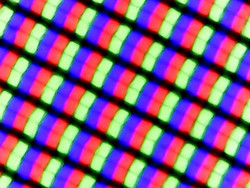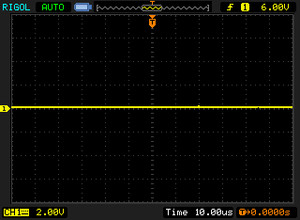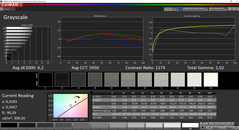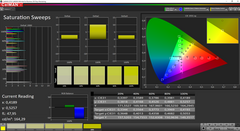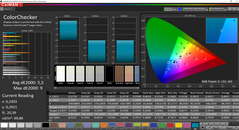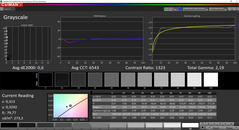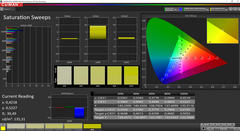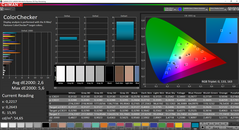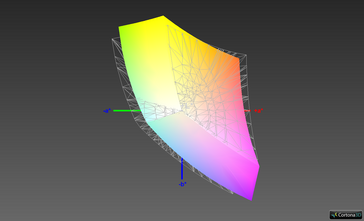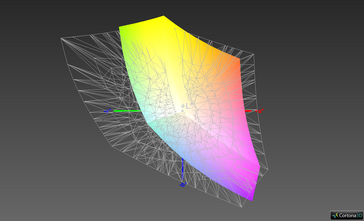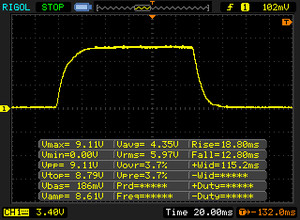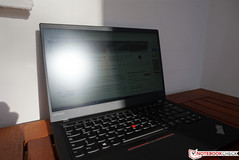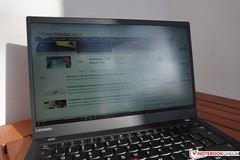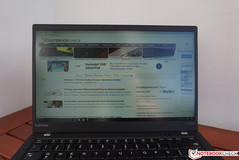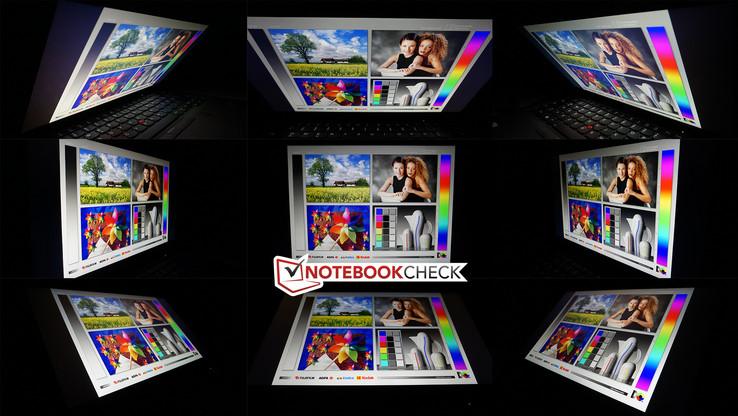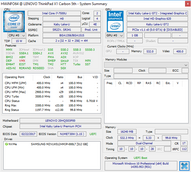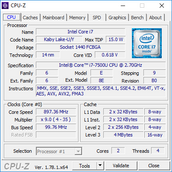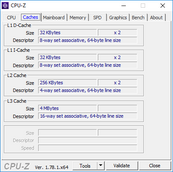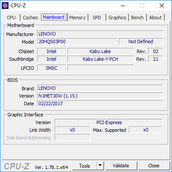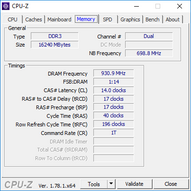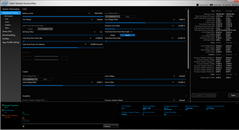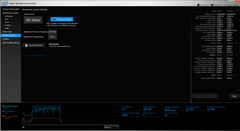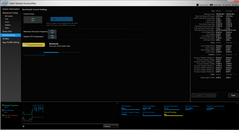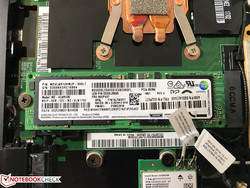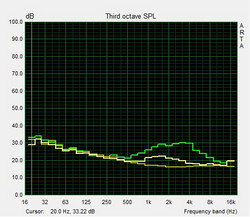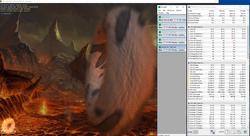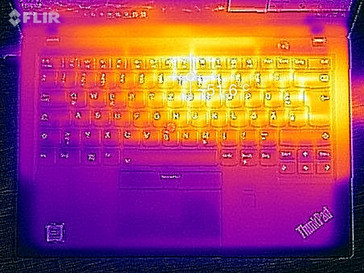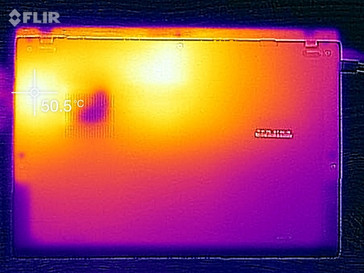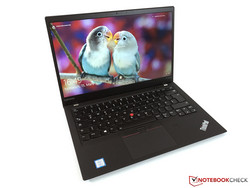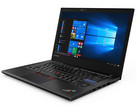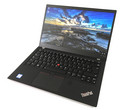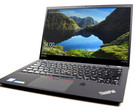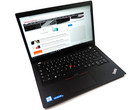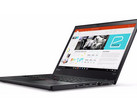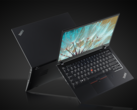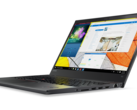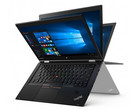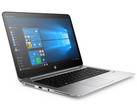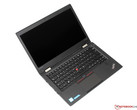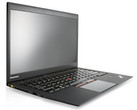Lenovo ThinkPad X1 Carbon 2017 (Core i7, Full-HD) Laptop Review
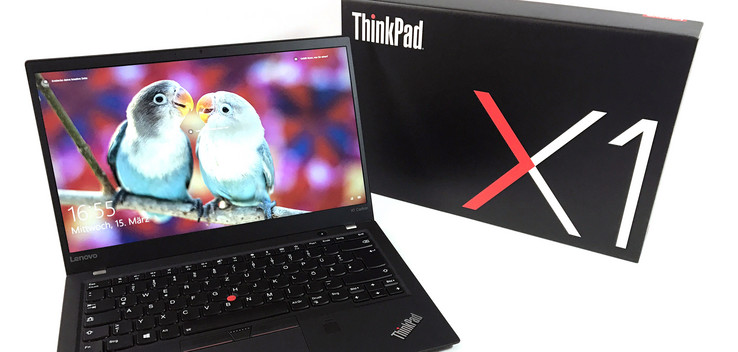
X1 Carbon is the designation of Lenovo's most expensive and portable business notebook lineup. The previous model was already one of the most compact and lightest business notebooks in general, but the 2017 model is another big evolution. Lenovo completely reworked the chassis, which is now even smaller and lighter than before. The port selection was updated as well – two full-fledged Thunderbolt 3 ports (40 Gbps) with USB-C jacks are extremely future-proof.
Change log:
- March 16th – Case comparison, microSD-card reader, display, processor, SSD, battery runtime
- March 17th – CPU performance under sustained workloads, input devices, temperature, stress test, video runtime
- March 20th – Case, ports, communication, maintenance, graphics card, idle runtime
- March 24th – Security, accessories, system performance, gaming, fans, speakers, power consumption, verdict, rating
There are multiple ways to get a ThinkPad X1 Carbon. The first option is Lenovo's own online store, where the systems can be configured within a certain scope, so you can build a machine based on your requirements. Another option is the Topseller program from common retailers. Those systems are pre-configured models and there are currently three Topseller models in Germany. We listed them in the table below:
| ThinkPad X1 Carbon (20HR0021GE) | ThinkPad X1 Carbon (20HR0027GE) | ThinkPad X1 Carbon (20HR002MGE) |
|---|---|---|
| Core i5-7200U | Core i5-7200U | Core i7-7500U |
| 8 GB LPDDR3-RAM | 8 GB LPDDR3-RAM | 16 GB LPDDR3-RAM |
| 256 GB NVMe-SSD | 512 GB NVMe-SSD | 512 GB NVMe-SSD |
| HD Graphics 620 | HD Graphics 620 | HD Graphics 620 |
| 1920 x 1080 pixels, IPS panel | 1920 x 1080 pixels, IPS panel | 1920 x 1080 Pixel, IPS panel |
| no WWAN | UMTS/LTE | UMTS/LTE |
| from 1,700 Euros | from 1,900 Euros | from 2,100 Euros |
Another – much more affordable – option is the Campus program, but it is limited to a certain user group. Students, teachers and eligible scientific employees can easily save a couple of hundred Euros with these special models. Our test sample is such a Campus model: The ThinkPad X1 Carbon for 1,599 Euros with a powerful Core i7-7500U processor, 16 GB RAM, FHD IPS display and a fast 512 GB NVMe-SSD. The components are therefore similar to the high-end Topseller SKU, but there is a catch: Our test model is usually shipped without operating system (was kindly installed by Campuspoint) and there is no support for WWAN modules. The usual "WWAN-ready" (prepared antennas) is not applicable for the X1 Carbon 2017 in general; LTE is either included or not supported at all, because the necessary antennas are not prepared.
Case
The previous ThinkPad T460s managed to reduce the gap to the ThinkPad X1 Carbon, so Lenovo went back to the drawing board and designed a new chassis for the current X1 Carbon 2017. It is even smaller than before (~1 cm less width and depth) and also lighter – the test model is extremely portable at just little more than 1.1 kg and can basically be stored anywhere.
Lenovo still uses a hybrid magnesium alloy for the base unit. The tactile feeling of the smooth surfaces is basically identical to the ThinkPad T470s. The new chassis design did not hurt the stability. Everything is extremely rigid and sturdy, and we can only warp the keyboard area slightly with a lot of pressure. You will not notice it in practice though.
The lid is made of a CFRP/GFRP hybrid (carbon fiber reinforced plastic/glass fiber reinforced plastic). The stability cannot keep up with the base unit, but we are still very happy with the performance. You need a lot of force to twist the display or dent it, but we could not provoke picture distortions or ripples on the screen. One typical weakness of ThinkPads is often the lower bezel between the hinges, which can easily be warped. This is only a minor issue on the test model and pressure only resulted in minor backlight bleeding.
We were not fully satisfied with the metal hinges of the previous ThinkPad X1 Carbon. Lenovo improved the construction and the hinges have no problem with the light screen. It can be opened with one hand and you can adjust it very precisely; bouncing is prevented very effectively. The maximum opening angle is still 180 degrees.
The perfect case then? Not quite. The build quality is extremely good in general, but there is a small flaw at the bottom cover. One user mentioned that the rear left corner of the cover is not sitting perfectly on the base and you can hear a slight clatter when you tap it. This is also the case for our test model, so this might be a general issue of the series. However, this can hardly change the excellent overall impression.
X1 Carbon 2017 vs. T470s vs. X270
We want to use the opportunity and compare the three most portable systems from Lenovo. The following pictures show the X1 Carbon 2017, the new ThinkPad T470s (here in review) and the latest iteration of the rather traditional subnotebook ThinkPad X270 (12.5 inches, review soon). The following pictures show the laptops at their highest luminance with the factory color profile (not calibrated).
You will immediately notice the color scheme. Lenovo now switched back to black for many models including the ThinkPad X1 Carbon as well as the ThinkPad T470s, but the ThinkPad X270 still uses the dark-gray chassis, which hardly changed since the ThinkPad X240. This impression continues when we carry the notebook around, because it just feels pretty bulky, despite the low weight of 1370 grams – not only compared to its siblings.
The larger ThinkPad T470s is even a tad lighter at 1364 grams and noticeably thinner than the small 12.5-inch model, but it obviously has a bigger footprint (also see comparison below). The new X1 Carbon 2017 is noticeably more compact than its predecessor since both the width and the depth were reduced by ~1 cm each. This means our test sample is right between the X1 Carbon 2016 and the X270 in this respect. We would always prefer the bigger display over the slightly smaller footprint.
Connectivity
Ports – 2x Thunderbolt 3
The redesigned chassis was also equipped with modern ports. There are now two USB-C connectors (Gen.2) including Thunderbolt 3 support at the left rear. They are full Thunderbolt 3 connectors (40 Gbps, DisplayPort 1.2a), so the ThinkPad X1 Carbon is very future-proof. The two ports also support PowerDelivery 2.0 to charge the device (USB-C PSU provided). This also compensates for the lack of a dedicated docking port. Old docking solutions cannot be used anymore, but Lenovo offers corresponding USB-C or Thunderbolt docks (including power supply). We will have a closer look at them in the Accessories section.
Despite the two universal USB ports, Lenovo fortunately implements a number of other ports. Two more regular USB 3.0 ports (USB 3.1 Gen.1 Type-A, 1x left, 1x right), a full-size HDMI port (1.4) and a Mini-Ethernet jack are not bad considering the slim construction. There is a corresponding adapter for the Mini-Ethernet jack in the box, just like an HDMI-VGA adapter (see picture). There is no criticism for the performance of the USB ports; we determined an average transfer rate of 384 MB/s in combination with the external Samsung SSD T3.
SD-Card Reader – only microSD
The ThinkPad X1 Carbon is unfortunately not equipped with a full-size SD-card reader. Instead, there is an additional slot for the microSD (UHS-II) in the SIM-card tray. It is, however, very tricky to access – you need a sharp object to open the tray (like a SIM tool for smartphones), and the slot is only accessible when the lid is closed.
We could not use our usual SD reference card, so we switched to our microSD reference card we usually use for smartphone reviews. It is the Exceria Pro M401 from Toshiba with advertised transfer rates of up to 95 MB/s (read) and 80 MB/s (write), respectively. AS SSD determines a decent maximum transfer rate of almost 83 MB/s, but jpg-pictures (~5 MB each) are copied at just 61 MB/s.
| SD Card Reader | |
| average JPG Copy Test (av. of 3 runs) | |
| Dell XPS 15 9560 (i7-7700HQ, UHD) | |
| Lenovo ThinkPad T470s-20HGS00V00 | |
| Lenovo ThinkPad T470-20HD002HGE | |
| Fujitsu LifeBook U747 | |
| Lenovo ThinkPad X1 Carbon 2017-20HQS03P00 | |
| maximum AS SSD Seq Read Test (1GB) | |
| Dell XPS 15 9560 (i7-7700HQ, UHD) | |
| Lenovo ThinkPad T470s-20HGS00V00 | |
| Lenovo ThinkPad T470-20HD002HGE | |
| Fujitsu LifeBook U747 | |
| Lenovo ThinkPad X1 Carbon 2017-20HQS03P00 | |
Communication
In addition to the wired Gigabit-Ethernet port, Lenovo equips the ThinkPad X1 Carbon with WiFi modules from Intel. Our test model is equipped with the M.2 adapter Dual-Band Wireless-AC 8265. It is a 2x2 module (2.4 & 5 GHz) with a maximum transfer rate of 867 Mbps in ac-networks. The Intel 8265 supports Bluetooth 4.2 in theory, but it is limited to 4.1 by the OS according to Lenovo. We did not experience any issues with the WiFi connection and our WLAN test with the router Linksys EA8500 (1m distance) also determines very good results.
We are a bit disappointed – especially on our test model – by the WWAN support. The corresponding M.2 slot is there, but there are no prepared antennas. "WWAN-ready" is not available for the ThinkPad X1 Carbon 2017. The device is either shipped with the corresponding LTE module or not; it is not upgradeable.
The manufacturer also offers an optional 802.11ad adapter (Intel 18625) with WiGig support, which is required for the optional wireless docking station. You can combine WWAN and WiGig on the ThinkPad X1 Carbon. NFC is optional, but not available on our test model.
Security
The security equipment with numerous passwords, TPM, the comfortable fingerprint scanner and the Kensington Lock is as comprehensive as usual, but larger ThinkPads still have an advantage in this respect. The X1 Carbon cannot be equipped with a SmartCard reader, which is mainly a problem for large companies or requires an external adapter, respectively. The spec sheet lists an optional IR camera with Windows Hello support, but there are currently no corresponding SKUs.
Accessories
The laptop is shipped with a 65-Watt USB-C power adapter, the usual service brochures as well as the aforementioned adapters (HDMI-VGA, Mini-Ethernet-Ethernet). Lenovo offers numerous generic accessories including bags, input devices or adapters. The ThinkPad X1 Carbon 2017 does not feature a dedicated docking port, but Lenovo offers corresponding solutions for the Thunderbolt port. One cable between the notebook and the docking station is sufficient for data & power supply.
Lenovo offers two solutions, one USB-C station (~200 Euros) as well as a Thunderbolt 3 station (~250 Euros). The latter offers more ports, but is a bit larger in return. Both will supply the laptop with power (up to 60 or 65 Watts, respectively) and they are compatible with all ThinkPads that are equipped with a corresponding connector.
Maintenance
It is pretty easy to access the components of the new ThinkPad X1 Carbon. The bottom panel is only secured by 5 regular Philips screws (only loosen, not remove). The front area has plastic clips and is mounted at the front. You should lift the rear of the panel and then pull it towards the rear.
Almost the whole front part of the chassis is filled with the battery. The components are located in the upper half, but you only have access to the fan, the M.2-SSD, as well as the WiFi module. Both the processor as well as the memory are soldered onto the mainboard. The following picture also shows that our test model lacks the WWAN antennas. The battery is secured by screws and can easily be replaced if necessary.
Warranty
The warranty period is typical for this class at 36 months and includes an on-site service, but the battery is only covered for one year. It is possible to extend the warranty period to five years and the manufacturer offers additional services like accidental protection.
Please see our Guarantees, Return Policies and Warranties FAQ for country-specific information.
Input Devices – further improved
Keyboard
The black AccuType keyboard of the new ThinkPad X1 Carbon looks identical, but the mechanics have improved, which is particularly noticeable in a direct comparison with the keyboard of the ThinkPad T470s. The keys of the X1 Carbon are still directly integrated into the base unit, while the T470s uses an additional frame. This further improves the stability and the area looks sleeker.
The keys of the previous X1 Carbon 2016 had a slightly shallower travel compared to the T-models, but this is not the case anymore. From a quality perspective, we even prefer the keyboard of the new X1 Carbon 2017, because it provides an even richer and more precise feedback. The typing sound is also noticeably duller, which leaves a more sophisticated impression. The larger keys like Return or the space bar are once again a bit louder.
The concave and grippy keys feature a two-stage white background illumination, which could be a bit brighter for our taste. We would also like to see a sensor in the future, which will automatically adjust the luminance depending on the environment. The typical ThinkPad layout can be slightly adjusted; it is possible to swap Fn and Ctrl, for instance.
The keyboard of the new ThinkPad X1 Carbon is therefore one of the best inputs in the mobile segment – and not only compared to slim notebooks. Even full-fledged workstations like the ThinkPad P70 are not equipped with better keyboards.
Touchpad & TrackPoint
As per usual, you can control the cursor via touchpad and the red TrackPoint, which has three dedicated mouse buttons. The latter obviously work with the touchpad as well.
Lenovo also improved this area. There is no more useless stripe between the dedicated buttons and the touchpad. Lenovo also uses a glass touchpad, which provides excellent gliding capabilities. Similar to all the other modern ThinkPads, it is a so called Precision touchpad, which means the inputs are processed by Windows directly. We liked the mouse replacement a lot and both movements as well as gestures (up to four fingers) are executed flawlessly. The touchpad is implemented as ClickPad, where the lower half can be pushed down. We once again get a very even and rich clicking sound on both sides. The whole touchpad is a bit lowered in the palm rest and therefore easy to find with the fingers.
The dedicated TrackPoint buttons were slightly changed and improved, because they are very well-integrated and there is no clatter - contrary to the T470s. The two buttons also provide similar feedback and clicking sounds.
The only drawback of this solution is the comparatively small touchpad surface. We only get 10 x 5.8 cm due to the dedicated buttons. This is sufficient, but many competitors just offer more space.
Display – Full-HD IPS
Lenovo once again offers two different panels for the new ThinkPad X1 Carbon 2017. Both 14-inch screens have a matte surface and are based on the IPS technology; the only difference is the resolution. The X1 Carbon 2017 is only available with Full HD panels (1920 x 1080 pixels) right now; the WQHD SKUs will probably be available mid 2017.
The FHD screen is still provided by AU Optronics (B140HAN03_1) and we cannot detect a PWM regulation of the luminance. Overall, the results are similar to the FHD SKU of the predecessor. The average luminance is a bit lower at almost 290 nits, but the black value (0.24) is better in return, which results in a very high contrast ratio of ~1300:1. Subjectively, we like the panel a lot, and there is only minor backlight bleeding in the two lower corners. You can also use the maximum luminance on battery power.
Screen Flickering / PWM (Pulse-Width Modulation)
| Screen flickering / PWM not detected | |||
In comparison: 53 % of all tested devices do not use PWM to dim the display. If PWM was detected, an average of 8108 (minimum: 5 - maximum: 343500) Hz was measured. | |||
| |||||||||||||||||||||||||
Brightness Distribution: 85 %
Center on Battery: 308 cd/m²
Contrast: 1296:1 (Black: 0.24 cd/m²)
ΔE ColorChecker Calman: 5.5 | ∀{0.5-29.43 Ø4.78}
ΔE Greyscale Calman: 6.2 | ∀{0.09-98 Ø5}
85.77% sRGB (Argyll 1.6.3 3D)
55.96% AdobeRGB 1998 (Argyll 1.6.3 3D)
62.4% AdobeRGB 1998 (Argyll 3D)
85.9% sRGB (Argyll 3D)
61.4% Display P3 (Argyll 3D)
Gamma: 2.02
CCT: 5950 K
| Lenovo ThinkPad X1 Carbon 2017-20HQS03P00 B140HAN03_1, , 1920x1080 | Lenovo ThinkPad X1 Carbon 20FB-005XUS 1920x1080 | Lenovo ThinkPad X1 Carbon 20FB003RGE VVX14T058J00, , 2560x1440 | Lenovo ThinkPad T470s-20HGS00V00 B140QAN01.5, , 2560x1440 | Lenovo ThinkPad T470-20HD002HGE N140HCA-EAB, , 1920x1080 | HP EliteBook Folio 1040 G3 AUO1136, , 2560x1440 | Fujitsu LifeBook U747 LG LP140WF3, , 1920x1080 | |
|---|---|---|---|---|---|---|---|
| Display | -3% | 10% | 12% | -30% | 12% | 2% | |
| Display P3 Coverage (%) | 61.4 | 58.9 -4% | 66.7 9% | 69 12% | 41.6 -32% | 67.9 11% | 66.1 8% |
| sRGB Coverage (%) | 85.9 | 83.1 -3% | 94.7 10% | 95.1 11% | 61.9 -28% | 96.8 13% | 84.8 -1% |
| AdobeRGB 1998 Coverage (%) | 62.4 | 60.3 -3% | 68.4 10% | 69.6 12% | 43.06 -31% | 70 12% | 62 -1% |
| Response Times | 0% | 9% | -2% | -4% | 2% | 20% | |
| Response Time Grey 50% / Grey 80% * (ms) | 41.6 ? | 47.2 ? -13% | 44 ? -6% | 46.4 ? -12% | 41.6 ? -0% | 46.4 ? -12% | 36 ? 13% |
| Response Time Black / White * (ms) | 31.6 ? | 27.6 ? 13% | 24 ? 24% | 28.8 ? 9% | 34 ? -8% | 26.4 ? 16% | 23.2 ? 27% |
| PWM Frequency (Hz) | 220 ? | ||||||
| Screen | 7% | 8% | -5% | -16% | 3% | 0% | |
| Brightness middle (cd/m²) | 311 | 321.7 3% | 272 -13% | 327 5% | 306 -2% | 327 5% | 291 -6% |
| Brightness (cd/m²) | 288 | 301 5% | 268 -7% | 311 8% | 287 0% | 316 10% | 296 3% |
| Brightness Distribution (%) | 85 | 89 5% | 95 12% | 88 4% | 88 4% | 87 2% | 84 -1% |
| Black Level * (cd/m²) | 0.24 | 0.294 -23% | 0.32 -33% | 0.25 -4% | 0.3 -25% | 0.35 -46% | 0.32 -33% |
| Contrast (:1) | 1296 | 1094 -16% | 850 -34% | 1308 1% | 1020 -21% | 934 -28% | 909 -30% |
| Colorchecker dE 2000 * | 5.5 | 3.96 28% | 2.61 53% | 6.1 -11% | 6.2 -13% | 4.39 20% | 4.3 22% |
| Colorchecker dE 2000 max. * | 9 | 6.69 26% | 6.43 29% | 12.2 -36% | 13.6 -51% | 7.27 19% | 7.5 17% |
| Greyscale dE 2000 * | 6.2 | 3.15 49% | 3.31 47% | 8.8 -42% | 5.8 6% | 4.69 24% | 4.3 31% |
| Gamma | 2.02 109% | 2.34 94% | 2.35 94% | 2.18 101% | 2.04 108% | 2.15 102% | 2.31 95% |
| CCT | 5950 109% | 7082 92% | 6360 102% | 6172 105% | 6277 104% | 7101 92% | 6529 100% |
| Color Space (Percent of AdobeRGB 1998) (%) | 55.96 | 53.8 -4% | 63 13% | 61.56 10% | 39.62 -29% | 62.52 12% | 55.46 -1% |
| Color Space (Percent of sRGB) (%) | 85.77 | 82.7 -4% | 95 11% | 94.88 11% | 61.44 -28% | 96.71 13% | 84.77 -1% |
| Total Average (Program / Settings) | 1% /
4% | 9% /
8% | 2% /
-1% | -17% /
-17% | 6% /
5% | 7% /
3% |
* ... smaller is better
We can determine comparatively high deviations compared to the sRGB reference color space ex-works. Average DeltaE-2000 deviations of 6.2 for the grayscale and 5.5 for the colors (up to 9), respectively, miss the target area (smaller 3); the previous model was better in this respect. The grayscale also reveals a slight yellowish cast in combination with a warm color temperature.
A calibration with our X-Rite i1Pro 2 spectrophotometer improves the grayscale performance in particular. The average DeltaE-2000 deviation drops to juts 0.6 – the human eye cannot see differences to the actual color in this range. The color performance improves as well and the average value drops below 3, but there are still some outliers towards 4-5. Still, both the color temperature and the RGB balance are much improved (color cast is gone), sou you should definitely calibrate the panel or use our icm. profile (linked in the box above).
No news for the color gamut: 85% sRGB and 56% AdobeRGB are superior to the FHD model of the ThinkPad T470, for example, but there is still a gap compared to the WQHD SKUs of the new T470s or the 2016 model of the X1 Carbon. The color gamut is not that important for everyday office tasks and picture editing is possible to a certain degree, but you should wait for the WQHD model or use an external monitor for professional picture editing or when you require high color accuracy.
Display Response Times
| ↔ Response Time Black to White | ||
|---|---|---|
| 31.6 ms ... rise ↗ and fall ↘ combined | ↗ 18.8 ms rise | |
| ↘ 12.8 ms fall | ||
| The screen shows slow response rates in our tests and will be unsatisfactory for gamers. In comparison, all tested devices range from 0.1 (minimum) to 240 (maximum) ms. » 85 % of all devices are better. This means that the measured response time is worse than the average of all tested devices (20.2 ms). | ||
| ↔ Response Time 50% Grey to 80% Grey | ||
| 41.6 ms ... rise ↗ and fall ↘ combined | ↗ 20.4 ms rise | |
| ↘ 21.2 ms fall | ||
| The screen shows slow response rates in our tests and will be unsatisfactory for gamers. In comparison, all tested devices range from 0.165 (minimum) to 636 (maximum) ms. » 66 % of all devices are better. This means that the measured response time is worse than the average of all tested devices (31.6 ms). | ||
We took advantage of the great weather and took some outdoor pictures in the worst-case scenario – direct sunlight without any clouds. The X1 Carbon 2017 is a good companion thanks to the high luminance (not reduced on battery) in combination with the good contrast ratio as well as the matte panel surface. You should avoid direct reflections from light sources, but you can see the contents very comfortably even in bright environments when you adjust your position. The IPS panel also ensures wide viewing angles.
Performance
It is no surprise that such a compact laptop cannot replace a grown-up mobile workstation. Lenovo still equips the ThinkPad X1 Carbon with modern Kaby-Lake ULV processors, which are even used for some 15-inch business laptops nowadays. The combination with SSDs (there are no conventional hard drives) results in a pretty powerful and responsive laptop for your regular office days. You either get 8 or 16 GB LPDDR3-RAM (dual-channel) depending on the SKU. Optional dedicated GPUs are not available, so the graphics output is only handled by the integrated GPU of the processor.
Processor – 25-Watt ULV-i7
Lenovo only ships the ThinkPad X1 Carbon 2017 with dual-core i5/i7 chips based on Intel's current Kaby Lake generation. Our test sample is equipped with the Core i7-7500U, the second-fastest 15-Watt-ULV processor with a maximum clock of 3.5 GHz (also for two cores). Hyper Threading is obviously supported as well, so the two cores can execute up to 4 threads simultaneously.
The configuration of the ThinkPad X1 Carbon 2017 does not differ from the other 2017 ThinkPads we reviewed so far: sustained power consumption of up to 25 Watts and a rather conservative temperature limit at 75 °C. Our Core i7-7500U reaches the temperature limit: The maximum clock of 3.5 GHz drops to ~3.3-3.4 GHz after 50% of the Cinebench R15 Multi Test due to the temperatures. This means you cannot use the full performance under sustained load, but the Turbo utilization for short load periods is still decent in general.
The CB Multi score is basically on par with the supposedly faster i7-7600U from the ThinkPad T470s. The i7-7600U, which is also available for the X1 Carbon 2017, should have similar issues compared to the T470s.
We also check the processor performance under sustained with a loop of the CInebench R15 Multi Test. The results is not really good, because the clocks will already drop significantly in the second run. The clocks fluctuate between 2.9-3.2 GHz after the third run and the resulting 324 points are even slightly behind the regular Core i5-7200U inside the ThinkPad T470, which can maintain the maximum 3.1 GHz.
If you cannot take advantage of the higher single-core frequency of the two Core i7 models, you should take a model with the Core i5, which should also have an advantage in respect to the temperatures. We will review an i5 X1 Carbon shortly to gather more information.
The processor performance is not reduced on battery power. More benchmark results for the Intel Core i7-7500U are available in our Tech section.
System Performance
The system performance of the new X1 Carbon 2017 is excellent. The combination of Core i7 processor, 16 GB RAM and the fast PCIe-SSD ensures smooth operation all the time. There are hardly any delays when you launch applications and we could not determine any other issues.
This impression is supported by the synthetic PCMark 8, because the test model is at the top of the charts both in the Work as well as the Home test. It is not possible to increase the performance even further; you would have to get a configuration with the Core i7-7600U, but the differences would be very small.
| PCMark 8 Home Score Accelerated v2 | 4025 points | |
| PCMark 8 Creative Score Accelerated v2 | 4874 points | |
| PCMark 8 Work Score Accelerated v2 | 4978 points | |
Help | ||
Storage Devices – Samsung PM961 NVMe-SSD
The compact chassis can only accommodate one storage solution – an M.2-SSD with the 2280 form factor. It is at least attached via PCIe-x4, so the performance of fast NVMe-SSDs is not limited. This is also the case for the PM961 SSD from Samsung with a storage capacity of 512 GB (454 GB free after Windows 10 installation). Both AS SSD and CrystalDiskMark determine very good transfer rates after the installation of Samsung's new NVM-Express driver (2.1). This means there are no problems or bottlenecks in practice and there is no reason to replace the drive – except you need more storage capacity. By the way, it is not possible to equip the free M.2-2242 slot (for the WWAN module) with an additional SSD according to Lenovo.
More benchmarks results are available in our HDD/SSD list.
| Lenovo ThinkPad X1 Carbon 2017-20HQS03P00 Samsung PM961 NVMe MZVLW512HMJP | Lenovo ThinkPad T470s-20HGS00V00 Samsung SSD PM961 1TB M.2 PCIe 3.0 x4 NVMe (MZVLW1T0) | Lenovo ThinkPad X1 Carbon 20FB003RGE Samsung SSD PM871 MZNLN256HCHP | HP EliteBook Folio 1040 G3 Samsung SM951 MZVPV256HDGL m.2 PCI-e | Fujitsu LifeBook U747 Samsung MZYTY256HDHP | Lenovo ThinkPad T470-20HD002HGE Samsung PM961 NVMe MZVLW512HMJP | |
|---|---|---|---|---|---|---|
| CrystalDiskMark 3.0 | 2% | -59% | -0% | -54% | -18% | |
| Read Seq (MB/s) | 1827 | 1760 -4% | 439.3 -76% | 1649 -10% | 504 -72% | 1155 -37% |
| Write Seq (MB/s) | 1383 | 1666 20% | 308.1 -78% | 1265 -9% | 497.8 -64% | 1076 -22% |
| Read 512 (MB/s) | 814 | 832 2% | 299.5 -63% | 1252 54% | 396.7 -51% | 811 0% |
| Write 512 (MB/s) | 1098 | 1064 -3% | 304.2 -72% | 1244 13% | 283.4 -74% | 862 -21% |
| Read 4k (MB/s) | 61 | 53.2 -13% | 34.05 -44% | 53.3 -13% | 35.73 -41% | 55.5 -9% |
| Write 4k (MB/s) | 172.2 | 167.4 -3% | 86.5 -50% | 159.9 -7% | 87.8 -49% | 134.6 -22% |
| Read 4k QD32 (MB/s) | 601 | 630 5% | 339.6 -43% | 559 -7% | 399.1 -34% | 496.2 -17% |
| Write 4k QD32 (MB/s) | 495.6 | 533 8% | 279.2 -44% | 376.7 -24% | 249.7 -50% | 425.4 -14% |
GPU Performance – HD Graphics 620
We already review the integrated graphics card Intel HD Graphics 620 numerous times. The maximum core clock is 1050 MHz in combination with the Core i7 and the dual-channel memory configuration ensures that the GPU can utilize its full potential. The performance of the iGPU is more than sufficient for everyday tasks including playback of high-resolution videos. The powerful video decoder can even handle efficient video editing if the application supports Intel's Quick Sync technology.
The HD Graphics 620 of the more powerful Core i7-7600U (ThinkPad T470s) is a bit faster in the benchmarks (7-8%), but we can see a clear advantage over the slightly lower clocked version of the Core i5-7200U in combination with single-channel RAM. Depending on the test, the additional memory bandwidth will result in 15-35% more performance. A dedicated graphics card like the Nvidia GeForce 940MX, which is currently available as an option for some business laptops, is about 60% faster.
Similar to the processor, the GPU performance is not reduced on battery power. More benchmarks for the HD Graphics are available on our dedicated page.
| 3DMark 11 Performance | 1815 points | |
| 3DMark Ice Storm Standard Score | 69541 points | |
| 3DMark Cloud Gate Standard Score | 6738 points | |
| 3DMark Fire Strike Score | 1001 points | |
Help | ||
Gaming Performance
You are limited to older or less challenging titles with the integrated graphics card of the processor. Despite the dual-channel memory configuration, however, the performance of the Intel HD Graphics 620 is only sufficient for low or medium settings. You should not even think about modern like Rise of the Tomb Raider, for example. The X1 Carbon is not a gaming notebook though, so this is no surprise. If you plan to play some games with the notebook, you might want to think about an external graphics card since the Thunderbolt 3 port (40 Gbps) does not limit the performance. Our gaming list shows what games can be played with the integrated HD Graphics 620.
| low | med. | high | ultra | |
|---|---|---|---|---|
| Tomb Raider (2013) | 93.5 | 45.2 | 27.6 | 12.8 |
| BioShock Infinite (2013) | 59.2 | 31.4 | 26.6 | 8.6 |
| Battlefield 4 (2013) | 43.5 | 30.1 | 20.1 | 6.4 |
| The Witcher 3 (2015) | 15.2 | |||
| Rise of the Tomb Raider (2016) | 20.2 | 11.8 |
Emissions
System Noise
The cooling solution of the ThinkPad X1 Carbon 2017 consists of two heat pipes and a fan, which dissipates the heat from the right side of the chassis. The laptop's passive cooling capabilities seem to be very limited, because the fan will start to spin even with short workloads.
This behavior slightly improved after the BIOS update to version 1.15 and the fan is often turned off with light workloads in particular. We observed this for a few days where we used the system as our primary working device. Our common tasks (multiple browser windows and tabs, WiFi browsing, writing reviews, YouTube videos, Skype etc.) usually resulted in a silent system, especially with the active power-saving profile. We measure up to 32.2 dB(A) with these workloads when the fan will start spinning.
Once you increase the stress, the small fan will quickly reach up to 34.4 dB(A). This includes the installation of applications or Windows updates, for example. We can once again notice that the fan immediately reacts to load changes and often starts spinning for a short time in practice. We did not record the maximum fan noise during our stress test this time (38.2 dB(A)), but with pure CPU load by Prime95. This once again supports that the Core i7 (more precisely the CPU part) is a small hot-head. You can clearly hear the measured 39.3 dB(A), but it is still on par with similarly slim systems like the ThinkPad T470s or the EliteBook Folio 1040 G3, for instance.
Noise level
| Idle |
| 29.3 / 29.3 / 32.2 dB(A) |
| Load |
| 34.3 / 39.3 dB(A) |
 | ||
30 dB silent 40 dB(A) audible 50 dB(A) loud |
||
min: | ||
| Lenovo ThinkPad X1 Carbon 2017-20HQS03P00 i7-7500U, HD Graphics 620 | Lenovo ThinkPad T470s-20HGS00V00 i7-7600U, HD Graphics 620 | Lenovo ThinkPad X1 Carbon 20FB003RGE 6500U, HD Graphics 520 | HP EliteBook Folio 1040 G3 6300U, HD Graphics 520 | Fujitsu LifeBook U747 i5-7200U, HD Graphics 620 | Lenovo ThinkPad T470-20HD002HGE i5-7200U, HD Graphics 620 | |
|---|---|---|---|---|---|---|
| Noise | -1% | 2% | 4% | 8% | 7% | |
| off / environment * (dB) | 29.3 | 28.9 1% | 29.1 1% | 29.1 1% | 28.2 4% | 28 4% |
| Idle Minimum * (dB) | 29.3 | 28.9 1% | 29.1 1% | 29.1 1% | 28.2 4% | 28 4% |
| Idle Average * (dB) | 29.3 | 28.9 1% | 29.1 1% | 29.1 1% | 28.2 4% | 28 4% |
| Idle Maximum * (dB) | 32.2 | 30.1 7% | 29.1 10% | 29.1 10% | 28.2 12% | 29.4 9% |
| Load Average * (dB) | 34.3 | 39.2 -14% | 35.6 -4% | 32.6 5% | 31.2 9% | 31.4 8% |
| Load Maximum * (dB) | 39.3 | 39.2 -0% | 38.1 3% | 37.8 4% | 33 16% | 34.6 12% |
* ... smaller is better
Temperature
The more compact chassis does unfortunately not have a positive effect on the temperature development. It stays very cool while idling and with light workloads, but it gets pretty warm under load.
You can clearly see the two hot spots on your infrared pictures below – at the processor and the cooling unit, where we can measure the highest temperatures: up to 48 °C at the top and 47 °C at the bottom, respectively. You should therefore not use the system on your lap in this scenario, but you will also notice the higher temperatures on the right side of the keyboard.
The stress test with the two synthetic tools Prime95 as well as FurMark is executed with 2.9-3.0 GHz (CPU) as well as 1050 MHz (GPU) at first, which corresponds with the maximum consumption of 25 Watts. By the way, the consumption limit would have to be significantly higher than 30 Watts for the maximum clocks of both components. The processor quickly reaches the rather conservative temperature limit of 75 °C. However, the surface temperatures are already very warm with this limit, so it is not unreasonable.
The consumption and therefore the clocks drop over the course of the test. The consumption will eventually (15-20 minutes) level off at 16-17 Watts: the processor runs at 1.8-1.9 GHz, the graphics card at 750-800 MHz. A 3DMark 11 run immediately after the stress test did not determine a lower score, so there should not be any limitations in everyday situations.
(-) The maximum temperature on the upper side is 48 °C / 118 F, compared to the average of 34.3 °C / 94 F, ranging from 21.2 to 62.5 °C for the class Office.
(-) The bottom heats up to a maximum of 47.2 °C / 117 F, compared to the average of 36.8 °C / 98 F
(+) In idle usage, the average temperature for the upper side is 22.2 °C / 72 F, compared to the device average of 29.5 °C / 85 F.
(+) The palmrests and touchpad are cooler than skin temperature with a maximum of 31.6 °C / 88.9 F and are therefore cool to the touch.
(-) The average temperature of the palmrest area of similar devices was 27.6 °C / 81.7 F (-4 °C / -7.2 F).
Speakers
The two stereo speakers leave a decent impression, even though there is obviously not much in terms of bass due to the slim construction. Movie and music playback therefore appears a bit tinny. Our audio analysis shows very linear highs and mids, which is good for voices in particular. The maximum volume is sufficient at around 78 dB(A). We already reviewed much worse speakers on business laptops.
You can obviously attach headphones or external speakers when you want to enjoy better quality for music or movies. We had no troubles with Bluetooth speakers or headphones and the stereo jack also provided a noise-free signal.
Lenovo ThinkPad X1 Carbon 2017-20HQS03P00 audio analysis
(±) | speaker loudness is average but good (78.2 dB)
Bass 100 - 315 Hz
(-) | nearly no bass - on average 16.5% lower than median
(±) | linearity of bass is average (8.7% delta to prev. frequency)
Mids 400 - 2000 Hz
(+) | balanced mids - only 2.9% away from median
(+) | mids are linear (5% delta to prev. frequency)
Highs 2 - 16 kHz
(+) | balanced highs - only 3.8% away from median
(+) | highs are linear (6% delta to prev. frequency)
Overall 100 - 16.000 Hz
(±) | linearity of overall sound is average (16.3% difference to median)
Compared to same class
» 18% of all tested devices in this class were better, 6% similar, 76% worse
» The best had a delta of 7%, average was 21%, worst was 53%
Compared to all devices tested
» 26% of all tested devices were better, 6% similar, 69% worse
» The best had a delta of 4%, average was 24%, worst was 134%
HP EliteBook Folio 1040 G3 audio analysis
(±) | speaker loudness is average but good (81.2 dB)
Bass 100 - 315 Hz
(-) | nearly no bass - on average 25% lower than median
(±) | linearity of bass is average (13.4% delta to prev. frequency)
Mids 400 - 2000 Hz
(+) | balanced mids - only 2.3% away from median
(±) | linearity of mids is average (7.1% delta to prev. frequency)
Highs 2 - 16 kHz
(+) | balanced highs - only 1.8% away from median
(+) | highs are linear (2.3% delta to prev. frequency)
Overall 100 - 16.000 Hz
(±) | linearity of overall sound is average (17.9% difference to median)
Compared to same class
» 28% of all tested devices in this class were better, 8% similar, 64% worse
» The best had a delta of 7%, average was 21%, worst was 53%
Compared to all devices tested
» 36% of all tested devices were better, 8% similar, 56% worse
» The best had a delta of 4%, average was 24%, worst was 134%
Frequency Comparison (Checkboxes select/deselectable!)
Energy Management
Power Consumption
Our consumption measurements show why Lenovo ships the ThinkPad X1 Carbon 2017 with a 65-Watt power adapter, despite the ULV processor. We determine almost 41 Watts with medium workloads and even more than 48 Watts at the start of the stress test. This value will drop in accordance with the previously mentioned performance reduction and fluctuates between 39-41 Watts after a couple of minutes. The idle values are not particularly efficient at 3.84-8.6 Watts, but still decent within the comparison group.
Lenovo only adds a charging symbol at the rear USB-C jack, but both ports can be used to charge the laptop. It has a nominal power output of 65 Watts and therefore sufficient headroom to charge the battery under load if necessary.
| Off / Standby | |
| Idle | |
| Load |
|
Key:
min: | |
| Lenovo ThinkPad X1 Carbon 2017-20HQS03P00 i7-7500U, HD Graphics 620, 1920x1080 | Lenovo ThinkPad T470s-20HGS00V00 i7-7600U, HD Graphics 620, 2560x1440 | Lenovo ThinkPad X1 Carbon 20FB003RGE 6500U, HD Graphics 520, 2560x1440 | HP EliteBook Folio 1040 G3 6300U, HD Graphics 520, 2560x1440 | Fujitsu LifeBook U747 i5-7200U, HD Graphics 620, 1920x1080 | Lenovo ThinkPad T470-20HD002HGE i5-7200U, HD Graphics 620, 1920x1080 | |
|---|---|---|---|---|---|---|
| Power Consumption | -13% | 7% | -22% | 5% | 20% | |
| Idle Minimum * (Watt) | 3.84 | 4.64 -21% | 3.8 1% | 6.3 -64% | 4.11 -7% | 3.21 16% |
| Idle Average * (Watt) | 6.3 | 8.93 -42% | 7.1 -13% | 9.4 -49% | 7.87 -25% | 6.15 2% |
| Idle Maximum * (Watt) | 8.6 | 9.12 -6% | 7.7 10% | 10.1 -17% | 8.74 -2% | 6.82 21% |
| Load Average * (Watt) | 41.9 | 42.2 -1% | 30.2 28% | 33.3 21% | 30.2 28% | 28.5 32% |
| Load Maximum * (Watt) | 48.7 | 47.3 3% | 44.7 8% | 49.5 -2% | 32.4 33% | 34.5 29% |
* ... smaller is better
Battery Runtime – Larger battery for longer runtimes
The chassis of the new ThinkPad X1 Carbon 2017 is more compact than before, but Lenovo uses the available space very well and implements are larger battery. The capacity of the lithium-polymer battery (3 cells) is now 57 Wh and therefore 5 Wh higher – also the highest value within our comparison group.
Our battery runtime measurements leave a positive impression. Maximum load (High Performance power profile, maximum luminance, wireless modules active) results in almost 2 hours – not bad considering the increased TDP limit and the full performance on battery power. Our practical WiFi test at an adjusted luminance of 150 nits (76% for our test model) and the Balanced power profile lasts more than 8 hours – almost one hour longer than the next best competitor.
The FHD model of the ThinkPad X1 Carbon is also very enduring in the video test (Big Buck Bunny, FHD, H.264, 150 nits). It only shuts down after almost 12 hours, which once again clearly beats the competitors. The Battery Eater Reader's Test /minimum luminance, maximum power-saver, wireless off) determined a maximum runtime of almost 21 hours.
We expect shorter battery runtimes for the optional WQHD panel due to the higher power consumption. We will obviously check that as soon as the corresponding SKUs are available (probably mid 2017).
RapidCharge is supported in combination with the 65-Watt power adapter (USB-C). Lenovo advertises that 80% of the capacity are charged after just one hour. Our test with a running system just misses this target – the battery was charged to 75% after one hour. The last 15% take the longest time in general; the total charging time of the battery is 2:20 hours.
| Lenovo ThinkPad X1 Carbon 2017-20HQS03P00 i7-7500U, HD Graphics 620, 57 Wh, 1920x1080 | Lenovo ThinkPad X1 Carbon 20FB003RGE 6500U, HD Graphics 520, 52 Wh, 2560x1440 | Lenovo ThinkPad T470s-20HGS00V00 i7-7600U, HD Graphics 620, 51 Wh, 2560x1440 | Lenovo ThinkPad T470-20HD002HGE i5-7200U, HD Graphics 620, 48 Wh, 1920x1080 | Fujitsu LifeBook U747 i5-7200U, HD Graphics 620, 50 Wh, 1920x1080 | HP EliteBook Folio 1040 G3 6300U, HD Graphics 520, 45.6 Wh, 2560x1440 | Lenovo ThinkPad X1 Carbon 20FB-005XUS 6300U, HD Graphics 520, 52 Wh, 1920x1080 | |
|---|---|---|---|---|---|---|---|
| Battery runtime | -12% | -21% | -8% | -11% | -22% | 0% | |
| H.264 (h) | 11.9 | 8.5 -29% | 7.6 -36% | 10.4 -13% | 8.2 -31% | 5.7 -52% | |
| WiFi v1.3 (h) | 8.3 | 7.2 -13% | 7 -16% | 7.3 -12% | 7.2 -13% | 5.2 -37% | 6.9 -17% |
| Load (h) | 1.8 | 1.9 6% | 1.6 -11% | 1.8 0% | 2 11% | 2.2 22% | 2.1 17% |
Pros
Cons
Vedict
Lenovo's new ThinkPad X1 Carbon is an extremely high-quality and well-built business notebook. It is clearly focused on the mobility, because the 14-inch system is very portable at little more than just 1.1 kg. The Chinese manufacturer was also able to reduce the footprint even further compared to the previous model.
The new chassis is also equipped with new ports. Lenovo not only implements two Thunderbolt 3 ports (USB-C jack), but also regular connectors like UBS-A or HDMI. This means the flagship device is future-proof without the constant need for an adapter. The input devices were further improved as well. The key travel is now on par with the larger T-series models; we even like the new keyboard a bit better thanks to the higher stability and the richer feedback. The glass touchpad also left a very good impression.
The Full HD panel of our test model manages decent results, but some consumer models show that there is still room for improvements. The optional WQHD panel will probably be available mid 2017, but the matte FHD IPS screen is certainly not a bad choice.
The new ThinkPad X1 Carbon is a very good business notebook and a great choice if you are looking for a very portable and versatile system. But the compact chassis also has drawbacks. You will have to live with high surface temperatures and a clearly audible fan when you really stress the system.
The performance leaves mixed impressions. The X1 Carbon 2017 is very fast in practice thanks to the Core i7 and the PCIe-SSD, but the cooling quickly struggles under sustained workloads. The Core i7 will drop below the performance potential of a Core i5 in this case and you will have to live with high surface temperatures as well as a quickly reacting fan.
X1 Carbon 2017 SKUs with the Core i5 might be the better choice when you consider all these aspects. The lower clocks should result in more headroom for the cooling solution and the temperatures should be lower as well. We will check this with a corresponding test model soon.
We really don't like the limitation for the LTE module. You have to know whether you need LTE or not before you buy the machine. The X1 Carbon 2017 has to be ordered with LTE or you will not be able to upgrade it afterwards due to the missing antennas. The microSD-reader is not very useful in our opinion, either. The slot is tricky to access and the usability of microSD-cards is limited, so you will probably have to use an external card reader anyway.
The combination of high-quality chassis, large screen, excellent input devices, comprehensive port selection, long battery runtimes and the high mobility still results in an extremely compelling and currently almost rivaled package, despite the mentioned drawbacks.
Lenovo ThinkPad X1 Carbon 2017-20HQS03P00
- 03/24/2017 v6 (old)
Andreas Osthoff




